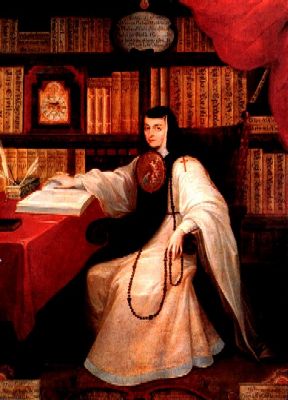Outline of Sor Juana Ines de la Cruz's La Repuesta (The Reply)
Sor Juana's Reply is structured much like a classical argument:
I. Exordium: One sets forth the subject and purpose of the discourse. It is important here to establish credibility (ethos) with the audience.
para. 1-2: She addresses the bishop of Puebla as if he were "Filotea de la Cruz." She wonders (sarcastically) how to thank "her" for publishing her letter, stresses her own low position, and conjectures that the publication of the letter was a kind of punishment from God. She concludes by stressing her dependence upon God's mercy.

para. 3: She discusses the irony of speaking about not speaking or understanding.
para. 4: She takes to heart the "lady's" admonition to spend more time on religious study and less on her secular writing. She expresses some awe and dread in taking upon herself the commentary on Scripture, for she notes that secular art is not punished for heresy in the same way that theological writing would be.
para. 5: From early on she has always been hungry for learning, which God continued to give her even when she desired him to take it away.
II. Narratio (The Statement of the Facts): One outlines the basic context for the discourse and the basics of the argument. In this case, Sor Juana uses this section of the argument to recount her own personal narrative.
para. 6-7: She recalls her desire for an education at three and her early successes, her desire at seven to be dressed as a boy so she could attend University, her early study of Latin, her cutting of her hair to punish herself for poor study, and her motive for entering convent life that she might pursue her studies.
para. 8-9: She stresses what she needed to learn in order to study Scripture and Theology--logic, physics, rhetoric, music, math, architecture, history, law, Patristic commentary, and astronomy. She also recognizes the greatest prerequisite for such study is "uninterrupted prayer and purity of life."
para. 10: She had no forced system of study, but then all subjects are interrelated because God has designed it so.
para. 11-13: She notes that what was unclear in the study of logic, she might learn in the study of rhetoric (or vice-versa). She also discusses the daily interruptions she experienced in convent life. Thus, she felt torn between the demands of knowledge and those of her fellow sisters, and she vowed to stress her studies whenever possible.
para. 14: She was tormented by those who considered her studies unfitting for a nun's "sacred innocence." She compares herself to a martyr. [The next nine paragraphs develop and clarify this point.]
para. 15-18: We "abhor [the] one who excels" she notes. Wasn't Christ abhorred for his divine beauty as the God-man? Wasn't he condemned for his miracle-working?
para. 19-20: Riches and power strike at reason, for few will allow that someone else is better.
para. 21: Christ's own crown of thorns was to punish his wisdom. Consequently, his triumph encourages others who are wise.
para. 22-23: Why do we oppose Christ for raising the dead? Sor Juana is persecuted not for her wisdom, but for her love of wisdom. She is like Peter who wished to be wise from afar without any risk to himself.
para. 24-27: She recalls when the Abbess banned her from study for three months. During that time, she "studied " everything she encountered: she closely observed the visual lines of how things were made; she meditated on the geometry in a child's top; she looked on a game of pick-up sticks, and made connections with the Star of David and the Trinity. She even made chemical observations as she cooked. It would be better for such a one to study books. Nonetheless, she trusts the lady to make the right decision concerning Sor Juana's studies.
III. Confirmatio (The Confirmation) & Refutatio (The Refutation): One advances the parts of the argument, and one answers counterarguments.
para. 28-29: She recounts a great catalogue of Hebrew and Greco-Roman female scholars and leaders.
para. 30-31: She undertakes to answer Arce's objection that women should not study and interpret scripture publicly in a pulpit or university setting. She stresses that only those who are able, men or women, should be allowed to do so. "Study is harmful" for the only half-informed and foolish. We should know the measure of our abilities.
para. 32-34: She willingly submits to correction of what she has written. Jerome believed his daughter Leta should be educated; shouldn't his spiritual daughters, the nuns, also be? Shouldn't older women teach younger women and thus keep them safe from ignorance as well as the temptations of male tutors?
para. 35: She reiterates her point that Scripture, as well as other secular texts, need extensive knowledge of the cultural context and often of the original languages in order to understand them aright.
para. 36: To illustrate this, she discusses two options in interpreting I Timothy 2:11, "Let the woman learn in silence," and shows that neither forbids women from private study.
para. 37: She defends her original letter's intent, audience, and impact.
para. 38: She recalls two notable instances mentioned by Arce of nuns' great intellectual abilities, and she suggests that they would have been better employed in more thorough study.
para. 39: She defends her writing of verse by pointing to examples from Scripture, Greco-Roman sources, and Church history, including Mary's Magnificat.
para. 40: She defends her writing in general. Her verse has never been found indecent and was always written at the request of others. Her letter was meant to be a personal answer not a published, learned commentary.
IV. Peroratio (The Conclusion): A summary of the discourse and an appeal to the audience's pathos.
para. 41-43: She concludes with a conventional politeness, including a pledge to always offer her writing for Your Reverence's correction, and asks for a pardon if she has breached the standard of decorum.
